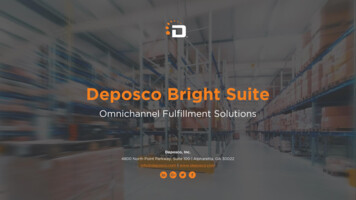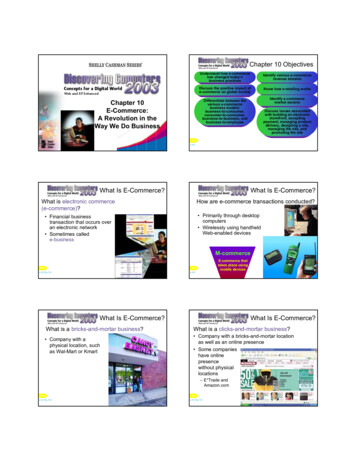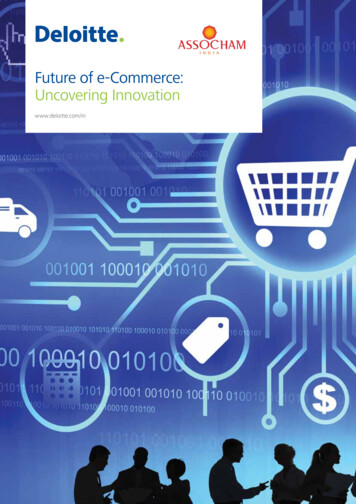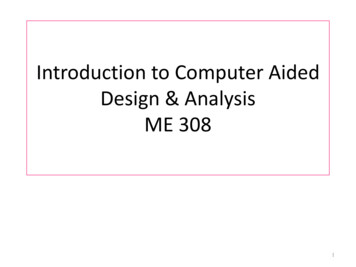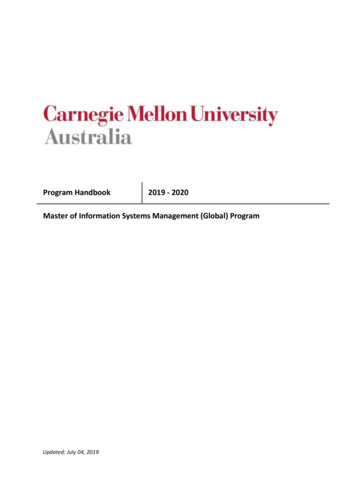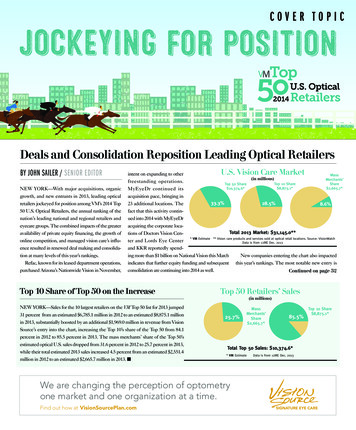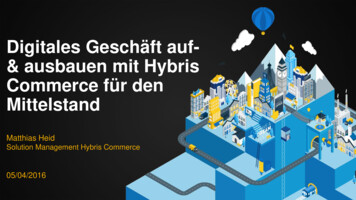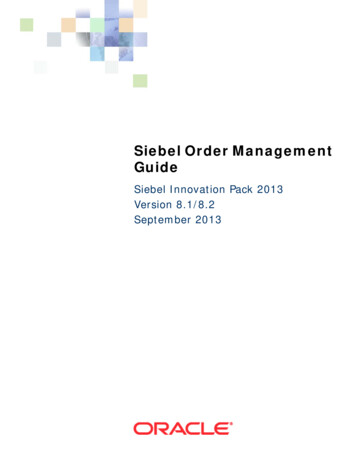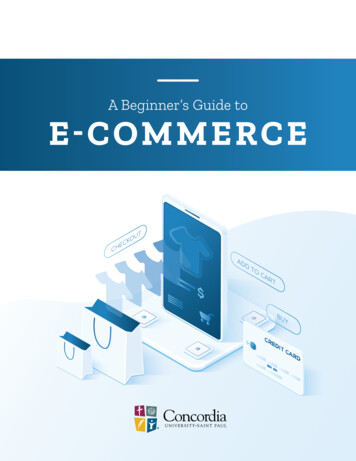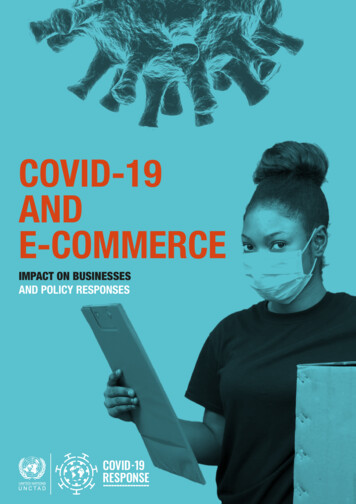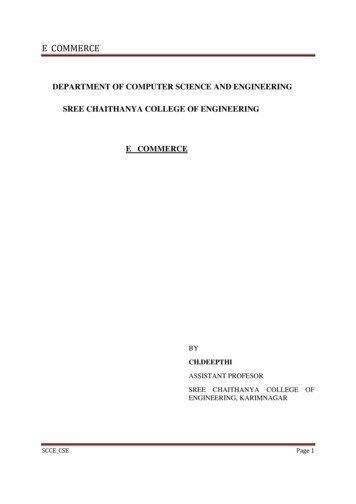
Transcription
E COMMERCEDEPARTMENT OF COMPUTER SCIENCE AND ENGINEERINGSREE CHAITHANYA COLLEGE OF ENGINEERINGE COMMERCEBYCH.DEEPTHIASSISTANT PROFESORSREE CHAITHANYA COLLEGEENGINEERING, KARIMNAGARSCCE CSEOFPage 1
E COMMERCEB.Tech IV/CSE IInd semesterTerm: 2010-2011SYLLABUSUNIT-1: Introduction, Electronic Commerce Framework, the Anatomy of E-Commerceapplications, E-Commerce Consumer applications, E-Commerce organization applications.UNIT-2: Consumer Oriented Applications, mercantile process models, mercantile models fromthe consumer’s perspective, Mercantile from the merchant’s perspective.UNIT-3: Types of Electronic Payment Systems, Digital Token-Based Electronic PaymentSystems, Smart Cards & Electronic Payment Systems, Credit Card- Based Electronic PaymentSystems, Risk & Electronic Payment Systems, Designing Electronic Payment Systems.UNIT-4: Electronic Data Interchange, EDI Applications in Business, EDI implementation,MIME, and value added networks.UNIT-5: Intra organizational E-Commerce, Macro forces and Internal Commerce, Work flowautomation and Coordination, Customization and Internal Commerce, Supply ChainManagement(SCM).UNIT-6: Making a business case for a Document Library, Digital document types, CorporateData warehouses, Advertising and Marketing, the new age of Information Based Marketing,Advertising on Internet, charting the Online marketing process, Market Research.UNIT-7: Consumer Search and Resource Discovery, information search and Retrieval,Electronic commerce catalogs or directories, Information Filtering.UNIT-8: Multimedia and Digital video, Key Multimedia concepts, Digital Video & ElectronicCommerce, Desktop Video Processing, Desktop Video Conferencing.Text Books: 1.Frontiers of electronic commerce –Kalakota, Whinston, Pearson2. E-Commerce, S.Jaiswal – GalgotiaSCCE CSEPage 2
E COMMERCEUnit- I1. Introduction: It is a general concept covering any form of business transaction or information exchangeexecuted using information and communication technologies (ICT’s) It includes electronic trading of goods, services and electronic material. It takes place between companies, between companies and their customers, or betweencompanies and public administrations.They can be classified by application type:1. Electronic Markets Present a range of offerings available in a market segment so that the purchaser cancompare the prices of the offerings and make a purchase decision.Example: Airline Booking System2. Electronic Data Interchange (EDI) It provides a standardized system Coding trade transactions Communicated from one computer to another without the need for printed orders andinvoices & delays & errors in paper handling It is used by organizations that a make a large no. of regular transactionsExample: EDI is used in the large market chains for transactions with their suppliers3. Internet Commerce It is use to advertise & make sales of wide range of goods & services. This application is for both business to business & business to consumer transactions.Example: The purchase of goods that are then delivered by post or the booking of ticketsthat can be picked up by the clients when they arrive at the event2. Scope of E-Commerce: Internet e-commerce is one part of the overall sphere of e-commerce.SCCE CSEPage 3
E COMMERCE3. Electronic Commerce and the trade cycle: It can be applied to all, or to different phases of the trade cycle The trade cycle various depending on The nature of the organizations Frequency of trade between the patterns to the exchange The nature of goods and services being exchanged Trade cycle support1. Finding goods and services (referred to as a search & negotiation)2. Placing the order, taking delivery & making payment (execution and settlement)3. After sales activities such as warrantee, services etc.The three generic trade cycles can be identified:1. Regular, repeat transactions (repeat trade cycle)2. Irregular transactions, where execution & settlement are separated (credit transactions)3. Irregular transactions where execution & settlement are combined (cash transactions)SCCE CSEPage 4
E COMMERCEElectronic Markets: It increases the efficiency of the market It reduces the search cost for the buyer & makes it more likely that buyer will continuethe search until the best buy is found It exist in commodity, financial markets & they are also used in airline booking system It is irregular transaction tradecycle.Electronic Data Interchange: Applications are sending test results from the pathology laboratory to the hospital ordispatching exam results from exam boards to school It is used trade exchanges Users are vehicle assemblers, ordering components for the supermarkets It is used for regular repeat transactions It takes quite lot of work to set up systems It is part of schemes for just-in-manufacture and quick response supply Mature use of EDI allows for a change in the nature of the product or service Mass Customization is such an exampleSCCE CSEPage 5
E COMMERCEInternet Commerce: The first stage Advertising appropriate goods and services Internet sites offer only information & any further steps down the trade cycle areconducted on the telephone The Second stage An increasing no. of sites offer facilities to execute & settle the transaction Delivery may be electronic or by home delivery depending on the goods and services The final stage After-sales service On-line support & On-Line services.SCCE CSEPage 6
E COMMERCEGeneric Framework of Electronic CommerceElectronic Commerce ApplicationsMultimedia Content & Network Publishing Infrastructure(Digital Video, Electronic Books, W orld W ide W eb)Messaging & Information Distribution Infrastructure(EDI, E-Mail, HyperText Transfer Protocol)Information Superhighway Infrastructure(Telecom, Cable TV, W ireless, Internet)Technical standardsfor electronicCommon Business Services Infrastructure(Security/Authentication, Electronic Payment, Directories/Catalogs)documents, multimediacontents, businessOnline Marketing and AdvertisingOnline ShoppingOnline Financial TransactionEducation and Researchtransactions, andnetworkprotocolsPublicpolicy, legal, economicaldevelopment, andprivacyissuesSupply Chain ManagementProcurement & PurchasingAudio and Video on DemandEntertainment and Gaming3. Electronic Commerce Framework E-Commerce application will be built on the existing technology infrastructure A myriad of computers Communication networks Communication software Common business services for facilitating the buying and selling process Messaging & information distribution as a means of sending and retrieving information Multimedia content & network publishing, for creating a product & a means tocommunicate about it The information superhighway- the very foundation-for providing the high way systemalong which all e-commerce must travel The two pillars supporting all e-commerce applications & infrastructure Any successful e-commerce will require the I-way infrastructure in the same way thatregular commerce needs I-way will be a mesh of interconnected data highways of many forms Telephone,wires,cable TV wire Radio-based wireless-cellular & satellite Movies video audioSCCE CSEPage 7
E COMMERCE Digital games music video software Electronic books text data graphics music photographs video In the electronic ‘highway system’ multimedia content is stores in the form of electronicdocuments These are often digitized On the I-way messaging software fulfills the role, in any no. of forms: e-mail, EDI, orpoint-to-point file transfers Encryption & authentication methods to ensure security Electronic payment schemes developed to handle complex transactions These logistics issues are difficult in long-established transportation4. Anatomy of E-Commerce applicationsE-Commerce applications are:1. Multimedia Content for E-Commerce Applications2. Multimedia Storage Servers & E-Commerce Applicationsi. Client-Server Architecture in Electronic Commerceii. Internal Processes of Multimedia Serversiii. Video Servers & E-Commerce3. Information Delivery/Transport & E-Commerce Applications4. Consumer Access DevicesSCCE CSEPage 8
E COMMERCEMultimedia Content for E-Commerce Applications Multimedia content can be considered both fuel and traffic for electronic commerceapplications. The technical definition of multimedia is the use of digital data in more than one format,such as the combination of text, audio, video, images, graphics, numerical data,holograms, and animations in a computer file/document. Multimedia is associated with Hardware components in different networks. The Accessing of multimedia content depends on the hardware capabilities of thecustomer.Multimedia Storage Servers & E-Commerce Applications: E-Commerce requires robust servers to store and distribute large amounts of digitalcontent to consumers. These Multimedia storage servers are large information warehouses capable of handlingvarious content, ranging from books, newspapers, advertisement catalogs, movies,games, & X-ray images. These servers, deriving their name because they serve information upon request, musthandle large-scale distribution, guarantee security, & complete reliabilityi. Client-Server Architecture in Electronic Commerce All e-commerce applications follow the client-server modelSCCE CSEPage 9
E COMMERCE Clients are devices plus software that request information from servers or interact knownas message passing Mainframe computing , which meant for “dump” The client server model, allows client to interact with server through request-replysequence governed by a paradigm known as message passing. The server manages application tasks, storage & security & provides scalability-ability toadd more clients and client devices (like Personal digital assistants to Pc’s. See in fig.ii. Internal Processes of Multimedia Servers The internal processes involved in the storage, retrieval & management of multimediadata objects are integral to e-commerce applications. A multimedia server is a hardware & software combination that converts raw data intousable information & then dishes out. It captures, processes, manages, & delivers text, images, audio & video. It must do to handle thousands of simultaneous users. Include high-end symmetric multiprocessors, clustered architecture, and massive parallelsystems.iii. Video Servers & E-CommerceThe electronic commerce applications related to digital video will include1. Telecommunicating and video conferencing2. Geographical information systems that require storage & navigation over maps3. Corporate multimedia servers4. Postproduction studios5. Shopping kiosks.SCCE CSEPage 10
E COMMERCE Consumer applications will include video-on-demand. The figure which is of video–on demand consist video servers, is an link between thecontent providers (media) & transport providers (cable operators)Information Delivery/Transport & E-Commerce Applications Transport providers are principally telecommunications, cable, & wireless industries.Transport RoutersInformation Transport ProvidersInformation Delivery Methods Telecommunication companieslong-distance telephone lines; local telephone lines Cable television companiesCable TV coaxial, fiber optic & satellite lines Computer-based on-line serversInternet; commercial on-line service providers Wireless communicationsCellular & radio networks; paging systemsConsumer Access DevicesInformation ConsumersAccess Devices Computers with audio & videoMobile computingPersonal/desktop computing capabilities Telephonic devices Consumer electronics Personal digital assistants (PDAs)SCCE CSEVideophoneTelevision set-top box Game systemsPen-based computing, voice-driven computingPage 11
E COMMERCEE-Commerce Consumer applications: People needs entertainment on demand including video, games, news on-demand,electronic retailing via catalogs etc. Currently now we are taking the video on-demand. Why most companies betting heavily on this?1. 93 million homes have television2. Americans spend nearly half their free time watching television3. Every evening, more than one-third of the population is in front of a television4. Sight, sound, and motion combine to make television a powerful means of marketing1. Consumer Applications and Social Interaction: Lessons from history indicate that the most successful technologies are those that maketheir mark social In 1945, in U.S no one had TV. By 1960 about 86percent of households did Now contrast with Telephone. Bell invented the telephone in 1876 and by1940, 40% ofU.S. households and by 1980 about 95-98 percent of households connected Penetration was slower for Telephone than for TV because of the effort needed to set upthe wiring infrastructure The impact of both was good on business, social, consumer behavior and entertainmenthabits Radio began in 1960, and by 1989, almost 3 decades later, just 319 radio stationsfollowed the news format In 1994, their number exceeded 1000What do Consumers really want?1. They want quality and cost of service2. If a new system requires more steps to do essentially the same things, consumers mayresist it3. Some people fit that mold, but most of public prefers to lay back and just watchtelevision and let someone else do the work of figuring out the sequence of televisionprogrammingSCCE CSEPage 12
E COMMERCEWhat are Consumers willing to spend?1. According to the video on-demand, consumers get the cable bill at basic charge they willbuy2. If it is doubled they will not buy and at the service provider economics will increasedthen network operators might look to advertises to fill the gapDelivering products to Consumers1. Packing and distribution must be considered2. Blockbuster video collects the information and shows the typical consumer3. Spends 12 a month on home video expenditures4. Go to video store to select video on limited budget and has time to kill5. Only periodically expends a large sum of moneyConsumer Research and E-CommerceConsumer opinion about interactive television is 46% be willing to pay 39% want video phone calls 63% would pay for movies on-demand 57% would pay for Television shows on-demand 78% said their worry about it is that they will pay for something that they previouslyreceived free of charge 64% are think it make it harder for viewers to protect privacy 41% are tell that it is too confusing to useChanging business Environment1. The traditional business environment is changing rapidly2. Many companies are looking outside and within to shape business strategies3. uppliers,distributors,industry groups etcconnectionsto4. The I-superhighway will expand this trend so that it allow business to exchangeinformation.SCCE CSEPage 13
E COMMERCEE-Commerce and the retail Industry1. Conditions are changing in the “new economy” with respect to the retail industry2. Consumers are demanding lower prices, better quality, a large selection of in-seasongoods.3. Retailers are filling their order by slashing back-office costs, reducing profit margins,reducing cycle times. buying more wisely and making huge investments in technology4. Retailers are in the immediate line of fire and were first to bear the brunt of cost cuttingMarketing and E-Commerce1. E-commerce is forcing companies to rethink the existing ways of doing target marketingand even event marketing.2. Interactive marketing is in electronic markets via interactive multimedia catalogs3. Users find moving images more appealing than still image and listening more appealingthan reading text on a screen4. Consumer information services are a new type of catalog businessInventory Management and Organizational Applications1. With borders opening up and companies facing stiff global competition2. Adaptation would include moving to computerized, “paperless” operations to reduce3. Once targeted business process is inventory management, solutions for these processes goby different names4. In manufacturing industry they’re known as just-in-time inventory systems, in the retailas quick response programs, and in transportation industry as consignment trackingsystemsSCCE CSEPage 14
E COMMERCEJust-in-Time (JIT) Manufacturing1. It is viewed as an integrated management system consisting of a number of differentmanagement practices dependent on the characteristics of specific plants2. The first principle is elimination of all waste (time,materials,labour & equipment)3. The following management practices are focused factory, reduced set-up times, grouptechnology, total productive maintenance, multifunction employees, uniform workloads,IT purchasing,kanban total quality control & quality circlesQuick Response Retailing (QR)1. It is a version of JIT purchasing tailored for retailing2. To reduce the risk of being of out of stock, retailers are implementing QR systems3. It provides for a flexible response to product ordering and lowers costly inventory levels4. QR retailing focuses on market responsiveness while maintaining low levels of stocks5. It creates a closed loop consisting of retailer, vendor, & consumer chain,& as consumersmake purchases the vendor orders new deliveries from the retailer through its computernetworkSupply Chain Management1. QR and JIT address only part of the overall picture2. Supply Chain Management (SCM) is also called “extending”, which means integratingthe internal and external partners on the supply and process chains to get raw materials tothe manufacturer and finished products to the consumer3. It includes following functions Supplier management: The goal is to reduce the number of suppliers and get them topartnersSCCE CSEPage 15
E COMMERCE Inventory management: The goal is to shorten the order-ship-bill cycle. When a majorityof partners are electronically linked, information faxed or mailed Distribution management: The goal is to move documents (accurate data) related toshipping Channel management: The goal is to quickly disseminate information about changingoperational conditions ( technical, product, and pricing information) to trading partners Payment management: The goal is to link company and the suppliers and distributors sothat payments can be sent and received electronically Financial management: The goal is to enable global companies to manage their money invarious foreign exchange accounts Sales force productivity: The goal is to improve the communication flow of informationamong the sales, customer & production functionsIn sum, the supply chain management process increasingly depends on electronic marketsWork group Collaboration Applications:1. A internetwork that enables easy and inexpensive connection of various organizationalsegments2. It is to improve communications and information sharing and to gather and analyzecompetitive data in real-time3. Videoconferencing, document sharing and multimedia e-mail, are expected to reducetravel and encourage telecommuting4. Improves the distribution channel for documents and records to suppliers, collaboratorsand distributorsSCCE CSEPage 16
E COMMERCEUnit- IICONSUMER-ORIENTED APLLICATIONS The wide range of applications envisioned for the consumer marketplace can be broadlyclassified into:(i) Entertainment(ii) Financial Services and Information(iii) Essential Services(iv) Education and TrainingConsumer Life-Style NeedsComplementary Multimedia Services EntertainmentMovies on demand, video cataloging, interactiveAds, Multi-user games, on-line discussions. Financial Services andFinancial news.Home Banking, Financial services, Information, Essential Servicesremote diagnostics.Home Shopping, Electronic Catalogs, telemedicine, Education and Trainingconferencing, on-line databases.Interactive education, multiuser games, video1. Personal Finance and Home Banking Management(i) Basic Services(ii) Intermediate Services(iii) Advanced services2. Home Shopping(i) Television-Based Shopping(ii) Catalog-Based Shopping3. Home Entertainment(i) Size of the Home Entertainment Market(ii) Impact of the Home Entertainment on Traditional Industries4. Micro transactions of InformationSCCE CSEPage 17
E COMMERCE1. Personal Finance and Home Banking Management: The newest technologies are direct deposit of payroll, on-line bill payment and telephonetransfers The technology for paying bills, whether by computer or telephone, is infinitely moresophisticated than anything on the market a few years ago In 1980s were the days of “stone age” technology because of technology choices foraccessing services were limited For home banking, greater demands on consumers and expanding need for information,it’s services are often categorized as basic, intermediate and advanced(i) Basic services These are related to personal finance The evolution of ATM machines from live tellers and now to home banking The ATM network has with banks and their associations being the routers and the ATMmachines being the heterogeneous computers on the network. This interoperable network of ATMs has created an interface between customer and bankthat changed the competitive dynamics of the industry. See in next figure Increased ATM usage and decrease in teller transactions The future of home banking lies with PC’sSCCE CSEPage 18
E COMMERCE(ii) Intermediate Services The problem with home banking in 1980 is, it is expensive service that requires a PC, amodem and special software As the equipment becomes less expensive and as bank offers broader services, homebanking develop into a comprehensive package that could even include as insuranceentertainment Consider the computerized on-line bill-payment system It never forgets to record a payment and keeps track of user account number, name,amount and the date and we used to instruct with payment instructions. See in Fig;(iii)Advanced Services The goal of advanced series is to offer their on-line customers a complete portfolio oflife, home, and auto insurance along with mutual funds, pension plans, home financing,and other financial products The Figure explains the range of services that may well be offered by banks in future The servic3es range from on-line shopping to real-time financial information fromanywhere in the world In short, home banking allows consumers to avoid long lines and gives flexibilitySCCE CSEPage 19
E COMMERCE2. Home Shopping: It is already in wide use. This enable a customer to do online shopping(i) Television-Based Shopping: It is launched in 1977 by the Home Shopping Network (HSN). It provides a variety of goods ranging from collectibles, clothing, small electronics, housewares, jewelry, and computers. When HSN started in Florida in 1977, it mainly sold factory overruns and discontinueditems It works as, the customer uses her remote control at shop different channels with touch ofbutton. At this time, cable shopping channels are not truly interactive(ii) Catalog-Based Shopping In this the customer identifies the various catalogs that fit certain parameters such assafety, price, and quality The on-line catalog business consists of brochures , CD-ROM catalogs, and on-lineinteractive catalogs Currently, we are using the electronic brochuresSCCE CSEPage 20
E COMMERCE3. Home Entertainment: It is another application for e-commerce Customer can watch movie, play games, on-screen catalogs, such as TV guide. In Home entertainment area, customer is the control over programming In Table tells the, What will be required in terms of Television-based technology for thistelemart to become a realityThe Telemart: Present and Future Functions Compressing and decodingThe transition to digital satellitea digital signal(images areand cable network head broadcompress to reduce quantitycasting involves linking the TVof information)to decoder to reconvert into ananalog signal Decoding a scrambledsignalThe broad casting of pay channelrequires the encryption of thesignal on emission & unscrambled Rapid loading of programon memoryAn increase in the no. of individualinteractive services is possibleonly if n/w overloading is keptminimum Electronic money orcard payment terminalOnce separated from the telephone,telemart will need a keyboardup to the TV set in order to ensureinteractivity. The keyboard willhave a payment connection tosimplify the billing processSCCE CSEPage 21
E COMMERCEAdvanced ServicesSize of the home Entertainment Market: Entertainment services are play a major role in e-commerce This prediction is underscored by the changing trends in consumer behavior. It is shown in TableImpact of Home entertainment on traditional industries: This will have devastating effects on theater business Economic issues might allow theaters to maintain an important role in the movie industry Today average cable bill is approximately 30 a monthIndustry Estimates of consumer Expenditures1980 ( 4.7 bin)1990 ( 31.0 bin)Theaters49.0% 2.314.5% 4.513.2% 5.0Basic cable35.0% 1.634.5% 10.736.9% 13.9Premium cable16.0% 0.816.5%14.0% 5.3 5.11993 ( 37.8 bin)Home video33.8% 10.534.8% 13.2Pay per view0.7%1.1% 0.2 0.44. Micro transactions of information: One change in traditional business forced by the on-line information business is thecreation of a new transaction category called small-fee transactions for micro services The customer by giving some information away for free and provide information bundlesthat cover the transaction overhead. The growth of small-money transfers could foster a boom in other complementaryinformation services The complexity is also increased in micro services when an activity named, reverificationis entered. It means checking on the validity of the transaction after it has been approvedDesirable Characteristics of an Electronic marketplace Critical mass of Buyers and sellers: To get critical mass, use electronic mechanismsSCCE CSEPage 22
E COMMERCE Opportunity for independent evaluations and for customer dialogue and discussion: Usersnot only buy and sell products, they compare notes on who has the best products andwhose prices are outrageous Negotiation and bargaining: Buyers and sellers need to able to haggle over conditions ofmutual satisfaction, money, terms & conditions, delivery dates & evaluation criteria New products and services: Electronic marketplace is only support full information aboutnew services Seamless interface: The trading is having pieces work together so that information canflow seamlessly Resource for disgruntled buyers: It provide for resolving disagreements by returning theproduct.Mercantile Process models Mercantile processes define interaction models between consumers and merchants for online commerceMercantile Models from the Consumer's Perspective(i) Pre purchase preparation: The pre purchase preparation phase include search and discoveryfor a set of products to meet customer requirements(a) The consumer information search process.(b) The Organizational search process.(c) Consumer search experiences.(d) Information brokers & brokerages.(ii) Purchase consummation: The purchase consummation phase include mercantile protocols(a) Mercantile process using digital cash.(b) Mercantile transaction using credit cards.(c) Costs of electronic purchasing.(iii) Post purchase interaction: The post purchase interaction phase includes customer service &supportSCCE CSEPage 23
E COMMERCE(i) Pre purchase Preparation The purchase is done by the buyers, so consumers can be categorized into 3 types Impulsive buyers, who purchase products quickly Patient buyers, purchase products after making some comparisons Analytical buyers, who do substantial research before making decision to purchaseproducts,.Marketing researches have several types of purchasing: Specifically planned purchases Generally planned purchases Reminder purchase Entirely unplanned purchasesThe consumer information search process Information search is defined as the degree of care, perception,& effort directed towardobtaining data or information related to the decision problemThe Organizational search process Organizational search can be viewed as a process through which an organization adaptsto such changes in its external environment as new suppliers, products, & services.SCCE CSEPage 24
E COMMERCEConsumer Search Experiences The distinction between carrying out a shopping activity “to achieve a goal” (utilitarian)as opposed to doing it because “ u love it” (hedonic).Information Brokers and Brokerages To facilitate better consumer and organizational search, intermediaries called informationbrokers or brokerages Information brokerages are needed for 3 reasons: Comparison shopping, reduced searchcosts, and integration(ii) Purchase Consummation Buyer contacts vendor to purchase Vendor states price Buyer and Vendor may or may not engage in negotiation If satisfied, buyer ask the payment to the vendor Vendor contacts billing service Billing service decrypts authorization and check buyers account balance Billing service gives to the vendor to deliver product Vendor delivers the goods to buyer On receiving the goods, the buyer signs and delivers receipt At the end of the billing cycle, buyer receives a list of transactionsSCCE CSEPage 25
E COMMERCEMercantile process using Digital Cash Buyer obtains e-cash from issuing bank Buyer contacts seller to purchase product Seller states price Buyer sends e-cash to seller Seller contacts his bank or billing service to verify the validity of the cash Bank gives okay signal Seller delivers the product to buyer Seller then tells bank to mark the e-cash as “used” currencyMercantile Transactions Using Credit Cards Two major components compromise credit card transactions in this process: electronicauthorization and settlement In retail transaction, a third-party processor (TPP) captures information at the point ofsale, transmits the information to the credit card issuer for authorization, communicates aresponse to the merchant and electronically stores the information for settlement andreporting. Th
E COMMERCE SCCE_CSE Page 2 B.Tech IV/CSE II nd semester Term: 2010-2011 SYLLABUS UNIT-1: Introduction, Electronic Commerce Framework, the Anatomy of E-Commerce applications, E-Commerce Consumer application
